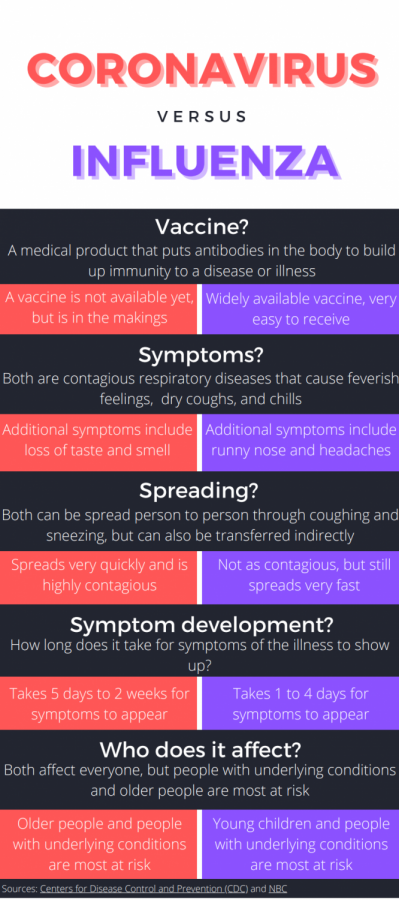Uncertainty arises as flu season coincides with coronavirus
More information at https://www.cdc.gov/ and https://www.nbcnews.com/
October 17, 2020
As the inevitable flu season draws near, many experts are scared of a “twindemic,” or the idea of two viruses circulating at the same time. This winter, it is the influenza and coronavirus.
The Centers for Disease Control and Prevention (CDC) states that influenza infects at least nine million people in the U.S. every year. Like the coronavirus, the flu is a highly contagious respiratory disease that can result in coughs, headaches and runny noses. While there is no cure for the flu, there are various known ways to provide care at home once infected, such as getting rest and drinking lots of fluids. Taking cough lozenges and over-the-counter medicines can also help.
“I think the upcoming flu season is going to make preventing coronavirus harder,” freshman Siddhi Surawkar said. “Since COVID-19 and the flu have similar symptoms, it will be hard to tell which one you have.”
The novelty of the COVID-19 continues to worry many. Although the virus first appeared almost a year ago, new discoveries are made everyday. In August, scientists at Johns Hopkins Medicine found that coronaviruses make an additional stop at the cellular level during their replication process, which helps them spread faster.
With two viruses coming up, experts recommend people follow CDC and National Institute of Health (NIH) guidelines, such as wearing a mask and staying six feet apart when in public.
“We don’t know much about COVID-19 in the winter season,” freshman Jessie Davis said. “We still need to remain vigilant about following the safety guidelines, which would not only stop the spread of COVID-19, but would also slow down transmission of the flu.”
It’s possible to have both the flu and the coronavirus at the same time. According to the CDC, both diseases on their own are very deadly, but a combination would likely be worse. The CDC also recommends that people take as many protective measures as possible, including getting the flu shot.
The vaccine is widely available for most people in the US, and a flu shot can take just five minutes. The CDC states that manufacturers are making almost 200 million flu vaccines this year, which is about 20 million more than the record set last year.
“This year, more than ever, is the time to get the flu shot,” Davis said. “We want to avoid the possibility of catching both COVID-19 and the flu.”
Although taking these actions are important to stop the flu, the coronavirus currently poses a far more deadly threat, according to the CDC. For instance, it takes about a week for COVID-19 symptoms to show, whereas flu symptoms appear within one to three days.
“COVID-19 is a new disease. We don’t have a common medicine and we don’t know its long term effects,” Surawkar said. “I would say that both viruses are equally concerning but since we know the effects of the flu, corona might be more dangerous this season.”
According to the CDC, children are highly susceptible to influenza. Thus, following proper health guidelines will be the first step towards a more normal school year.
“I think if we practice good hygiene skills like washing hands frequently, cleaning down surfaces and staying home when sick,” Davis said, “then we can minimize the spread of both COVID-19 and the flu.”



